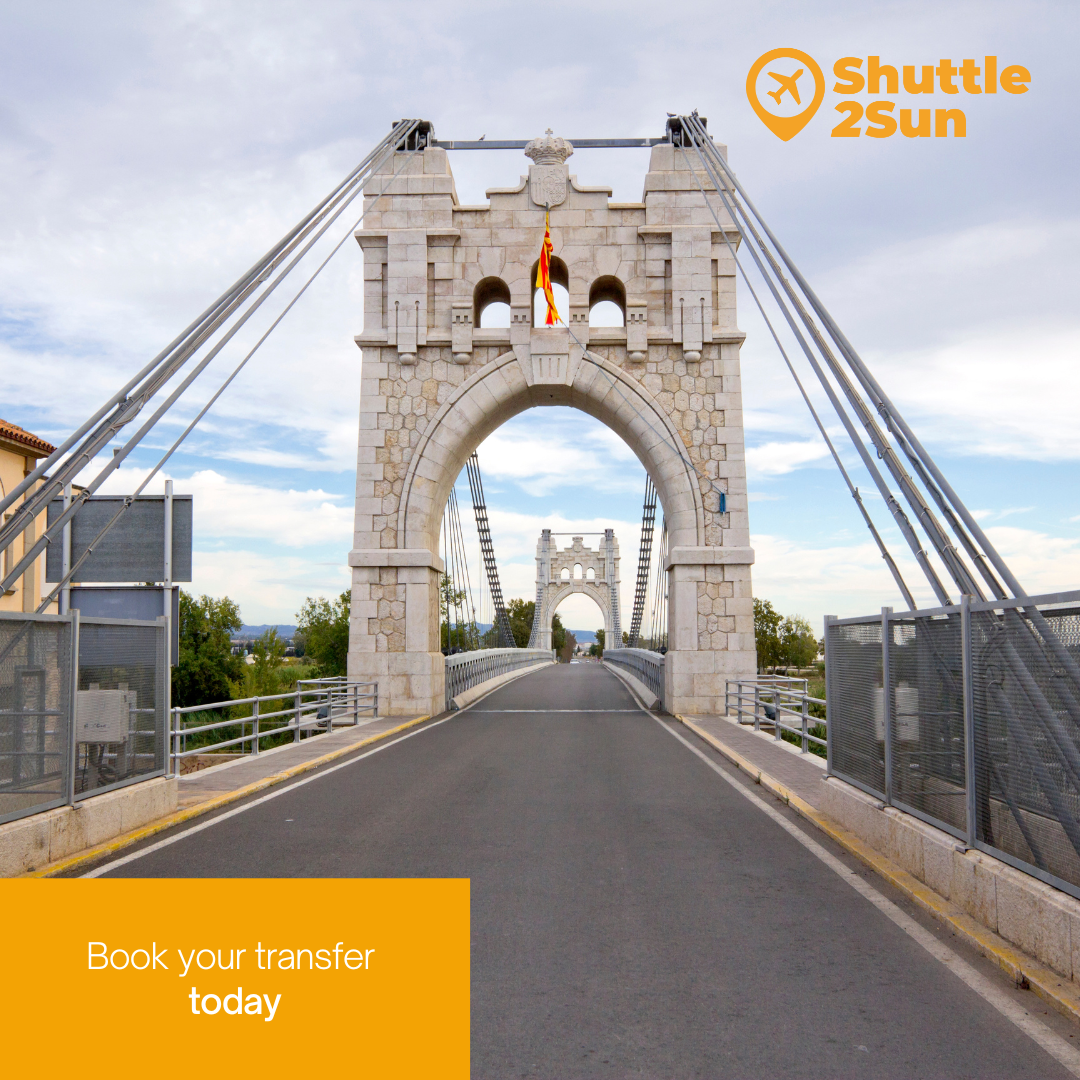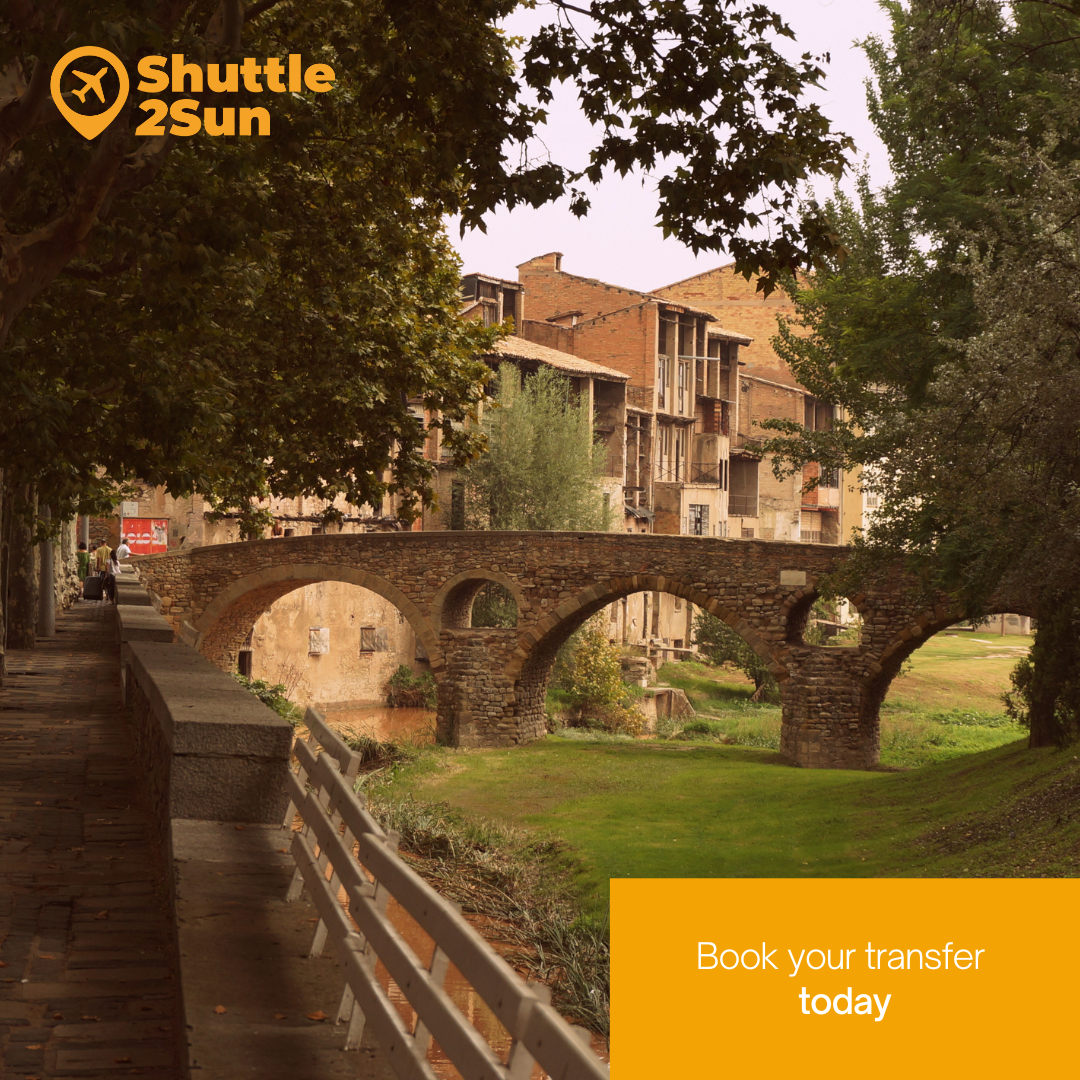For centuries, bridges have been much more than just architectural structures; they are silent witnesses to the passage of time, connectors of territories and symbols of the historical and cultural evolution of a region. In Catalonia, these stone, iron and wood monuments tell stories spanning from Roman times to the present today, offering visitors dreamlike landscapes and a direct connection with the past and present of this land.
A tour of Catalonia’s most emblematic bridges is a fascinating trip through history and engineering. In this article, we will visit destinations such as Tarragona, Barcelona, Girona, Amposta, Vic and Besalú, discovering how these impressive structures have stood the test of time or have been renovated to adapt to modern times.
If you’re a lover of history, architecture or simply looking for charming spots to explore, we invite you to discover some of the most outstanding bridges in Catalonia. Get to your destination with Shuttle2Sun‘s low-cost and sustainable shared transfer services and private transfer services from Barcelona Airport, Barcelona Port, Reus Airport, Girona Airport and Camp de Tarragona AVE train station.
Tarragona’s Pont del Diable, an imposing Roman work of art
Also known as the Ferreres Aqueduct, Tarragona’s Pont del Diable is one of the most impressive structures from the Roman period in Catalonia. Built more than 2,000 years ago, this 217-metre-long, 26-metre-high aqueduct was built to supply water to ancient Tarraco, one of the most important cities of the Roman Empire on the Iberian Peninsula.
This bridge, declared a World Heritage Site by UNESCO, is set in a stunning natural landscape, making it a must-see for lovers of history and hiking. Its impeccable state of conservation is an example of the high level of engineering in ancient Rome.
Martorell’s Pont del Diable, a witness to the Middle Ages
Martorell’s Pont del Diable is another of Catalonia’s most iconic bridges, although its origin is very different from that of its namesake in Tarragona. Built in the 13th century on Roman remains, this medieval Gothic-style bridge stands over the Llobregat river with pointed arches, which in its day was one of the greatest architectural feats in Europe.
Its name comes from a popular legend that tells how the devil helped build it in exchange for the soul of the first living being to cross it. In the end, the villagers managed to trick him by making an animal pass before anyone else.

The Pont del Bisbe, a Gothic corner in the heart of Barcelona
In the heart of Barcelona’s Gothic quarter, the Pont del Bisbe is one of the most photographed corners of the city. This elegant neo-Gothic bridge, built in 1928 by the architect Joan Rubió i Bellver, connects the Casa dels Canonges with the Palau de la Generalitat, creating a unique medieval atmosphere on Carrer del Bisbe.
One of the most intriguing details of this bridge is the presence of a carved skull on its underside. According to legend, anyone who stares at it could be trapped in a curse. Other tales claim that the skull grants wishes to those who dare to make them under its arch.
With Shuttle2Sun‘s low-cost and sustainable shared transfer services and private transfer services, you can get to Barcelona from Barcelona Airport, Barcelona Port, Reus Airport, Girona Airport and Camp de Tarragona AVE train station.

The Pont de les Peixateries Velles, work of the genius Eiffel
Girona’s Iron Bridge, also known as the Pont de les Peixateries Velles, is one of the city’s most unique constructions. Designed by Gustave Eiffel before the construction of his iconic tower in Paris, this red metal bridge crosses the Onyar River and connects the old town with the modern part of Girona.
What makes this bridge special is its structure, which contrasts with the surrounding medieval architecture. From it, you can get spectacular views of the famous coloured houses of the Onyar river, one of the most picturesque landscapes of the city.
The Amposta Suspension Bridge, symbol of the Ebre River
The Amposta Suspension Bridge is one of the most emblematic structures in the Terres de l’Ebre. Inaugurated in 1921, this 134-metre-long bridge was the first of its kind in Spain and was a milestone in the civil engineering of the time. With its stone towers and steel cables, it stands majestically over the Ebre river, offering an impressive visual spectacle.
The Pont de Queralt, the medieval charm of Vic
Located in the historic city of Vic, the Pont de Queralt is a medieval jewel that has survived the passage of time.
Built in the 11th century over the Mèder river, this stone bridge has several arches and a setting that invites calm and contemplation. Its importance lies in the fact that it was the main entrance to the town in medieval times, a key point for traders and travellers.
The Besalú Bridge, an icon of Catalan Romanesque architecture
If there is one bridge that looks like something out of a mediaeval fairy tale, it is the Besalú Bridge. This spectacular Romanesque bridge, built between the 11th and 12th centuries, stands over the Fluvià river with its characteristic stone towers and arches. Its image is one of the most representative of Catalonia’s mediaeval heritage.
Besalú is one of the most charming villages in the region, and its bridge is undoubtedly its most famous emblem. Walking across it is fells like stepping back in time, immersing yourself in a past rich with history and legends. It is the ideal starting point for discovering the medieval town and all its magical corners.
Catalonia is a land of bridges that unite past and present, history and modernity. Each of these bridges is an invitation to discover the cultural richness of the region and to marvel at its architectural beauty. If you want to discover all these Catalan destinations, Shuttle2Sun offers its shared transfer services and private transfer services, low-cost and sustainable, from Barcelona airport, Barcelona port, Reus airport, Girona airport and Camp de Tarragona AVE train station.



